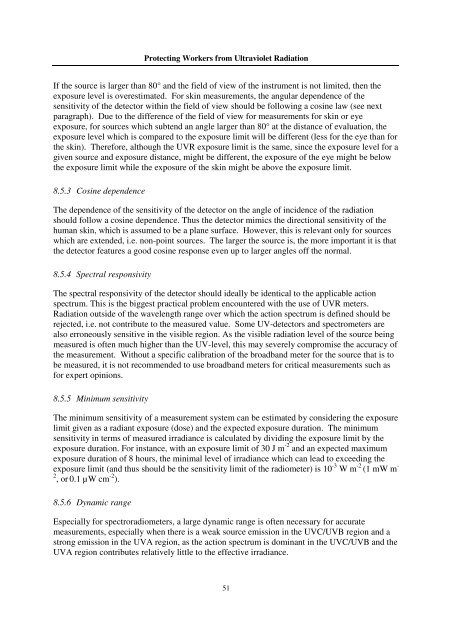Protecting Workers from Ultraviolet Radiation - icnirp
Protecting Workers from Ultraviolet Radiation - icnirp
Protecting Workers from Ultraviolet Radiation - icnirp
You also want an ePaper? Increase the reach of your titles
YUMPU automatically turns print PDFs into web optimized ePapers that Google loves.
<strong>Protecting</strong> <strong>Workers</strong> <strong>from</strong> <strong>Ultraviolet</strong> <strong>Radiation</strong><br />
If the source is larger than 80° and the field of view of the instrument is not limited, then the<br />
exposure level is overestimated. For skin measurements, the angular dependence of the<br />
sensitivity of the detector within the field of view should be following a cosine law (see next<br />
paragraph). Due to the difference of the field of view for measurements for skin or eye<br />
exposure, for sources which subtend an angle larger than 80° at the distance of evaluation, the<br />
exposure level which is compared to the exposure limit will be different (less for the eye than for<br />
the skin). Therefore, although the UVR exposure limit is the same, since the exposure level for a<br />
given source and exposure distance, might be different, the exposure of the eye might be below<br />
the exposure limit while the exposure of the skin might be above the exposure limit.<br />
8.5.3 Cosine dependence<br />
The dependence of the sensitivity of the detector on the angle of incidence of the radiation<br />
should follow a cosine dependence. Thus the detector mimics the directional sensitivity of the<br />
human skin, which is assumed to be a plane surface. However, this is relevant only for sources<br />
which are extended, i.e. non-point sources. The larger the source is, the more important it is that<br />
the detector features a good cosine response even up to larger angles off the normal.<br />
8.5.4 Spectral responsivity<br />
The spectral responsivity of the detector should ideally be identical to the applicable action<br />
spectrum. This is the biggest practical problem encountered with the use of UVR meters.<br />
<strong>Radiation</strong> outside of the wavelength range over which the action spectrum is defined should be<br />
rejected, i.e. not contribute to the measured value. Some UV-detectors and spectrometers are<br />
also erroneously sensitive in the visible region. As the visible radiation level of the source being<br />
measured is often much higher than the UV-level, this may severely compromise the accuracy of<br />
the measurement. Without a specific calibration of the broadband meter for the source that is to<br />
be measured, it is not recommended to use broadband meters for critical measurements such as<br />
for expert opinions.<br />
8.5.5 Minimum sensitivity<br />
The minimum sensitivity of a measurement system can be estimated by considering the exposure<br />
limit given as a radiant exposure (dose) and the expected exposure duration. The minimum<br />
sensitivity in terms of measured irradiance is calculated by dividing the exposure limit by the<br />
exposure duration. For instance, with an exposure limit of 30 J m -2 and an expected maximum<br />
exposure duration of 8 hours, the minimal level of irradiance which can lead to exceeding the<br />
exposure limit (and thus should be the sensitivity limit of the radiometer) is 10 -3 W m -2 (1 mW m -<br />
2 , or 0.1 µW cm -2 ).<br />
8.5.6 Dynamic range<br />
Especially for spectroradiometers, a large dynamic range is often necessary for accurate<br />
measurements, especially when there is a weak source emission in the UVC/UVB region and a<br />
strong emission in the UVA region, as the action spectrum is dominant in the UVC/UVB and the<br />
UVA region contributes relatively little to the effective irradiance.<br />
51



